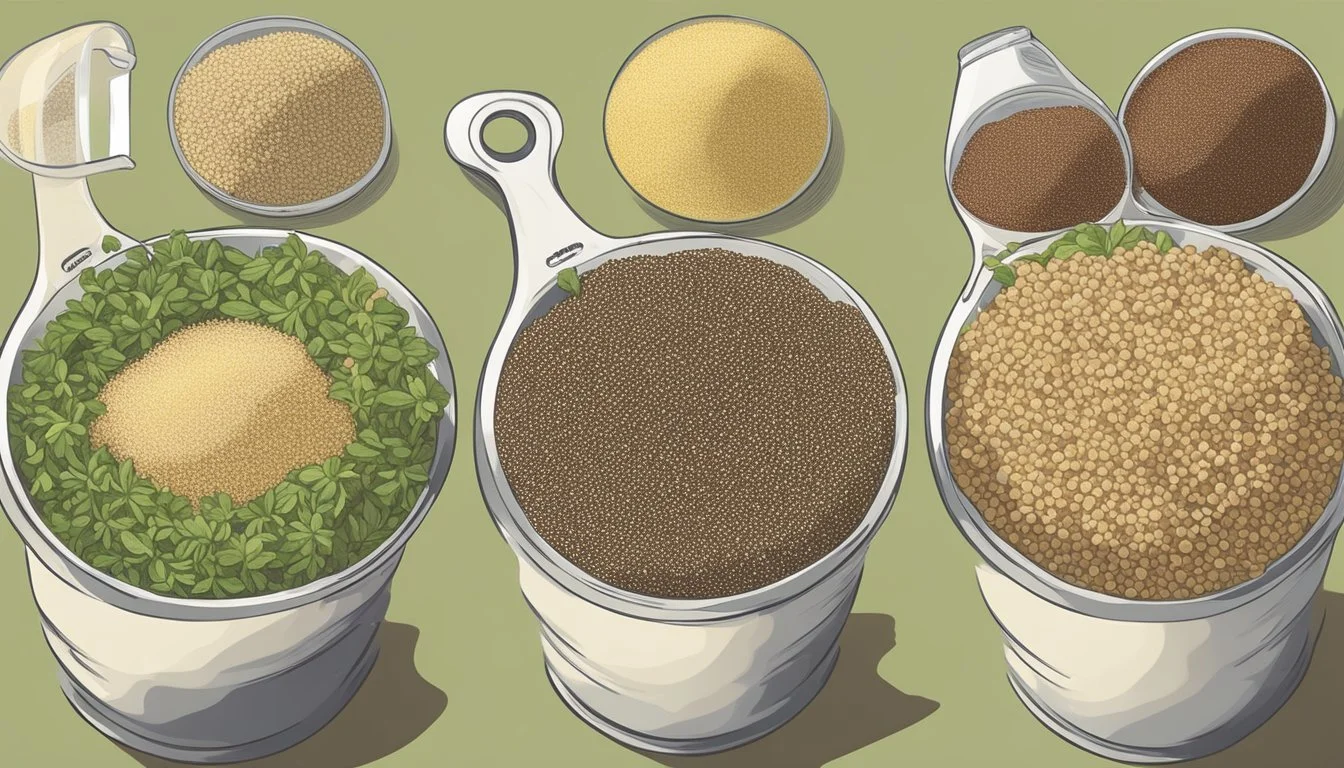How to Substitute Amaranth for Quinoa
A Guide to Swapping Ancient Grains
Amaranth and quinoa (What wine goes well with quinoa?) are two grains that frequently pique the interest of health-conscious individuals due to their high nutritional value and versatility in recipes. While both grains boast a rich protein content and a similar appearance, they each offer unique textural qualities and flavors that can complement different types of dishes. Swapping amaranth for quinoa can be an excellent way to explore different grain profiles or to cater to specific dietary needs.
Quinoa, with its fluffy and slightly nutty appeal, has become a household staple in the realm of healthy grains. It's well-suited to a variety of dishes, ranging from salads to stir-fries. Amaranth, on the other hand, has a more distinct, earthy flavor and possesses a stickier texture when cooked, which makes it an ideal substitute particularly in recipes where a creamy or gelatinous consistency is desired, such as porridges and puddings.
When substituting amaranth for quinoa, it’s important to understand the cooking properties of both grains. Amaranth's smaller size and sticky texture can be used to thicken dishes, whereas quinoa's ability to maintain individual grains after cooking lends itself to a different range of culinary applications. Adjusting cooking times and liquid ratios is crucial when using amaranth in place of quinoa to achieve the desired outcome in any given recipe.
Understanding Amaranth
In exploring how to substitute amaranth for quinoa, one must first understand the history, nutritional content, and culinary uses of amaranth to appreciate its role as both a substitute and a stand-alone ingredient.
History of Amaranth
Amaranth is an ancient grain with a rich history dating back to the Aztecs, where it was not only a staple food but also used in religious ceremonies. It has been cultivated for over 8,000 years, and while it's considered a pseudo-cereal like quinoa, it's not a true grain. Amaranth's resurgence in modern diets is due in part to its gluten-free properties and robust nutrient profile.
Nutritional Comparison with Quinoa
Amaranth holds its own when compared to quinoa, particularly regarding their protein and nutrient content. Amaranth is a protein-rich, naturally gluten-free option that contains a complete protein, meaning it includes all nine essential amino acids. Here's how it stacks up against quinoa in nutritional terms:
Calories: Amaranth has slightly more calories per cup than quinoa.
Protein: Both grains offer a rich protein content, with amaranth providing approximately 9 grams per cooked cup.
Fiber: Equal at 5 grams per serving, they are beneficial for digestive health.
Nutrients: Amaranth includes a wide range of vitamins and minerals, making it comparable to quinoa's nutritional profiles.
Culinary Uses of Amaranth
Amaranth's versatility in the kitchen extends from sweet to savory dishes. With a slightly nutty and earthy flavor, it can be used in various culinary applications:
Porridge: Its gelatinous quality when cooked makes it suitable for breakfast porridges.
Baked Goods: As a gluten-free option, it serves as an excellent ingredient in baking and can be used to create lighter textures in baked goods.
Soups and Stews: Its ability to thicken can enhance the consistency of soups and stews.
Salads and Side Dishes: Amaranth can be fluffed up and added to salads or served as a side like pilaf, providing a distinct nutty flavor.
Being naturally gluten-free, amaranth stands as a superfood, especially useful for those seeking ancient grains as substitutes for conventional grains in their cooking repertoire.
How to Cook Amaranth
Cooking amaranth skillfully can transform it into a versatile base for a range of dishes. With its unique texture and nutritional profile, amaranth serves as a suitable substitute for quinoa in many recipes.
Basic Preparation of Amaranth
To prepare amaranth, one begins by rinsing the grains under cold water to remove any saponin, which can give a bitter taste. In a medium-sized pot, combine one cup of the rinsed amaranth with two cups of water. Bring this mixture to a boil, then reduce the heat to allow it to simmer. Amaranth will cook for approximately 20 minutes, or until the water is absorbed and the grains have puffed up slightly, achieving a porridge-like consistency.
For a fluffier texture akin to cooked quinoa (how long does cooked quinoa last?), decrease the water slightly and fluff the amaranth with a fork after cooking. Alternatively, to achieve a sticky and more gelatinous texture, one might opt for a 1:3 ratio of amaranth to water, which is suitable for creating pilafs or incorporating the grain into recipes that benefit from a more cohesive texture.
Amaranth to Quinoa Cooking Ratios
When substituting amaranth for quinoa, it's key to consider the end texture of the desired dish. If the intention is to create a side dish similar to a quinoa pilaf, a 1:1 substitution ratio of amaranth to quinoa will work well. However, due to the naturally stickier texture of amaranth, one might opt for a slightly increased water ratio to give the amaranth grains a looser quality, making it better resemble the fluffy texture of cooked quinoa.
Dish Type Quinoa Ratio Amaranth Ratio Pilaf 1 cup to 2 cups water 1 cup to 2.5 cups water Salad Base 1 cup to 2 cups water 1 cup to 2 cups water Porridge 1 cup to 2 cups water 1 cup to 3 cups water
Remember to adjust the cooking time and water ratios slightly based on the desired consistency. They can also flavor the cooking water with broth or add spices to infuse the amaranth with additional taste. When using amaranth in salads, cook the grains until just done to maintain a bit of bite, then let them cool and dry so that they mix well with other salad ingredients without affecting the texture adversely.
Incorporating Amaranth in Diverse Dishes
Amaranth is an ancient grain that is a nutritional powerhouse, suitable for a range of dishes due to its satisfying texture and subtle nutty flavor. It is an excellent gluten-free substitute that graces breakfast, salads, and baking with its presence.
Amaranth in Breakfast Dishes
Amaranth grains can star in breakfast dishes, such as porridge or as an addition to granola. For a creamy porridge, simmer amaranth seeds in water or milk until tender, which usually takes about 20-25 minutes. Enhance its flavor with cinnamon or fresh fruit. Alternatively, for a crunchy twist, pop the grains using a dry pan and sprinkle over yogurt or blend in a food processor to include in homemade granola recipes.
Using Amaranth in Salads and Side Dishes
This gluten-free grain can transform salads and side dishes. It adds a chewy texture and pairs well with a variety of vegetables, nuts, and dressings. To incorporate amaranth into salads, cook the grain and let it cool before mixing with greens, vegetables, and a vinaigrette. For side dishes like pilafs or cold salads, consider adding herbs, spices, or a squeeze of lemon for a vibrant flavor profile.
Amaranth for Soups and Stews
In soups and stews, amaranth can act as a thickening agent while also contributing nutrients and texture. Simply add the grains directly into the pot and allow them to simmer until they reach a soft consistency. This application not only thickens the soup or stew but also incorporates the grain's health benefits seamlessly into comforting dishes.
Baking with Amaranth Flour
When baking with amaranth flour, its gluten-free property is particularly beneficial for those with dietary restrictions. The flour imparts a light, airy texture and a sweet, nutty flavor to baked goods. When using amaranth flour as a substitute for traditional flour, a 1:1 ratio is typically recommended. However, due to its high absorbency, adjustments to the liquid content of recipes may be necessary to achieve the desired consistency.
Amaranth Versus Other Gluten-Free Grains
Amaranth stands out as a nutritious gluten-free option with a rich profile of protein and essential minerals, offering a valuable alternative in various dishes typically made with grains like quinoa.
Amaranth Compared to Millet and Buckwheat
Amaranth and Millet: Both are ancient gluten-free grains noted for their fiber content, yet amaranth generally boasts a higher protein content, making it a stronger nutritional substitute for quinoa in dishes like pilaf. Millet, on the other hand, is lighter and more neutral in taste, offering versatility in both sweet and savory recipes.
Amaranth and Buckwheat: Despite its name, buckwheat is a gluten-free pseudocereal and not related to wheat. Buckwheat groats have a robust flavor and are used in traditional dishes like kasha. Amaranth's nutritional profile is comparable, though it usually contains more magnesium as highlighted by one cup of raw amaranth holding 519 milligrams of magnesium compared to buckwheat's 393 milligrams.
Contemplating Amaranth and Brown Rice
Brown rice is a widely consumed gluten-free grain offering a nutty flavor and chewy texture. It serves as a staple in many gluten-free diets as a side dish or a base for other ingredients. Although brown rice is a nutritious option, amaranth typically surpasses it in protein, fiber, and key minerals such as magnesium and iron, thereby providing a denser nutrient profile beneficial for those seeking nutrient-rich substitutes for quinoa.
Amaranth and Other Pseudocereals
Pseudocereals like amaranth, quinoa, teff, and sorghum are all gluten-free and share a common status as nutrient-dense alternatives to traditional grains. Amaranth is comparable to these substitutes in terms of nutritional content, often excelling in its offering of amino acids like lysine. It is a preferred ingredient for those exploring gluten-free options beyond quinoa, especially given its higher levels of several minerals such as calcium, magnesium, and phosphorus when compared to quinoa. Meanwhile, sorghum offers a mild flavor and versatility similar to that of millet, while teff is prized for its iron content, though it is less commonly found in Western markets.
Health Benefits of Amaranth
Amaranth, an ancient grain that is naturally gluten-free, offers a robust nutrient profile with an abundance of health benefits. It stands out as a high-fiber, high-protein food that contributes positively to various aspects of health, from weight management to cardiovascular support.
Amaranth's Impact on Weight Management
Amaranth is low in calories but high in fiber and protein, which are essential for weight management. Protein helps in maintaining muscle mass during weight loss, while fiber assists in keeping one feeling full, thus reducing overall calorie intake.
Fiber content: High
Protein content: High
Caloric content: Low
Cardiovascular and Bone Health Advantages
Enriched with magnesium and potassium, amaranth can support heart health by aiding in blood pressure regulation and reducing cholesterol levels. The grain's high calcium and iron content is vital for strong bones and the prevention of anemia.
Heart health:
Magnesium: Helps manage blood pressure.
Potassium: Contributes to heart function.
Bone health:
Calcium: Essential for bone structure.
Iron: Key for blood health and connective tissue.
Nutrient Contribution to General Wellbeing
Packed with essential vitamins, minerals, and antioxidants, amaranth contributes to overall wellbeing. With a significant presence of nutrients like manganese, phosphorus, and zinc, it aids in the body's various biochemical processes.
Minerals: Rich in manganese, phosphorus, zinc
Vitamins: Contains essential vitamins
Antioxidants: Helps combat oxidative stress
Amaranth's nutritional composition demonstrates its capacity to be a beneficial addition to a healthy diet, accommodating individuals who require nutritious foods for various dietary needs.





